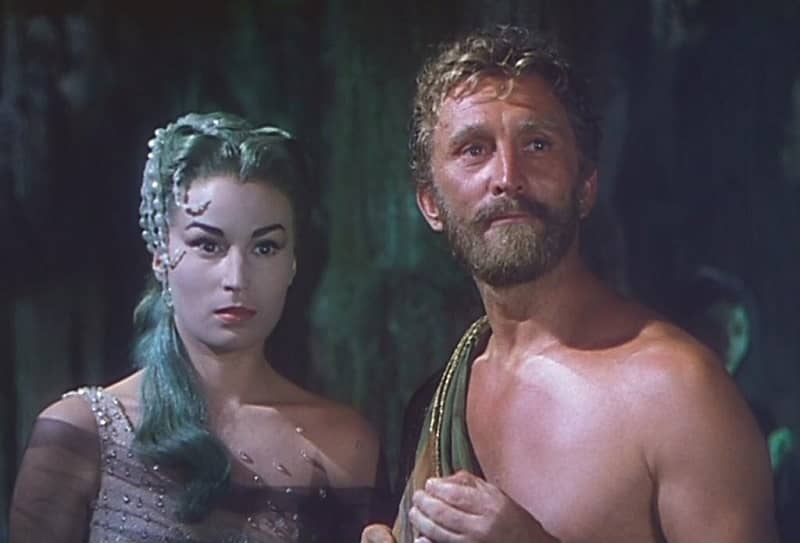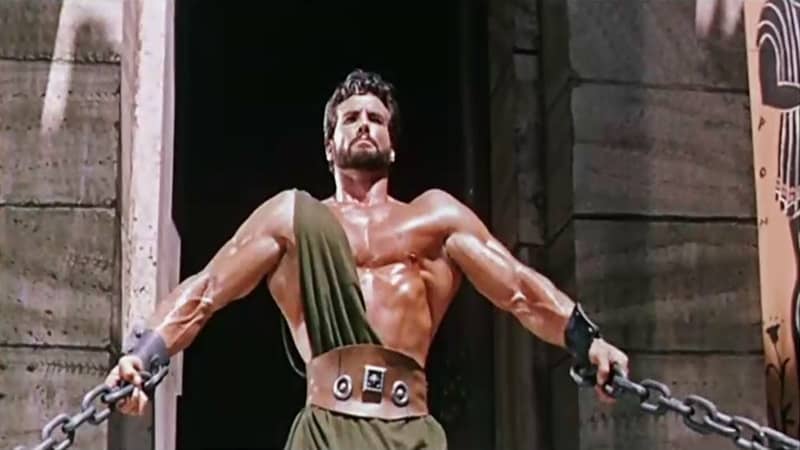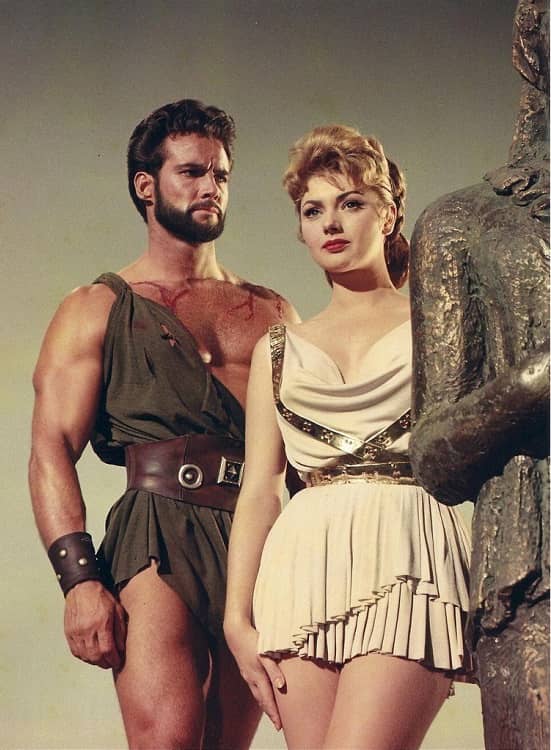Ellsworth’s Cinema of Swords: Classic, Mythic, and Epic
Silvana Mangano and Kirk Douglas in Ulysses (1954)
Ryan Harvey has written extensively here about the peplum movie or Italian sword-and-sandal craze of 1959-65, a phenomenon that had an immediate origin in three films: Ulysses, which showed that there was a postwar Italian market for adventure films from the era of myth; Hercules, which proved you could make such a movie popular on both sides of the Atlantic; and Hercules Unchained, which demonstrated there was a formula for repeated success. These were well-crafted movies that aimed much higher than most of their successors and provided solid, and occasionally even thoughtful entertainment. If you’re unfamiliar with them I’m pleased to introduce you, and if they’re old friends you can join me in appreciation.
Ulysses
Rating: ****
Origin: Italy, 1954
Director: Mario Camerini
Source: Lionsgate DVD
Kirk Douglas made his reputation in Hollywood in the late Forties as a leading man in a series of intense, dramatic roles. By 1954 he was ready for a change of pace: action hero! He signed on with Disney for 20,000 Leagues Under the Sea and with Dino De Laurentiis in Italy for the epic Ulysses, based, of course, on Homer’s The Odyssey. This was a big-budget production, with lavish sets, exteriors shot on Mediterranean islands, and a lovely full-scale Greek galley. Plus, of course, a cyclops.
The movie starts and ends with a framing sequence set in Ithaca, where Queen Penelope (Silvana Mangano) waits for Ulysses (Douglas) to return from the Trojan War while fending off the unwanted advances of a crowd of Greek nobles who are convinced her missing husband is dead. The most pressing of these suitors, Antinous (Anthony Quinn), is close to browbeating her into marrying him.
Meanwhile, Ulysses washes up on the shore of nearby Phaeacia, bereft of memory after a shipwreck. (Neptune, god of the sea, has it in for Ulysses because of a little temple defilement incident during the sack of Troy.) The story unfolds in scenes of flashback as Ulysses’ memory gradually returns: the Trojan Horse, Polyphemus the Cyclops, the Sirens, and the hero’s enchantment by the witch Circe (also played by Silvana Mangano in a clever twist). Ulysses regains his memory just in time to return to Ithaca and… well, you know how the story goes.
Douglas makes a fine Ulysses: he could maybe be a little more intellectual, but he nails the hero’s reckless bravado, and as he proved many times thereafter, he’s great in an action role. Mangano underplays both her roles, which is the right decision because it gives Penelope’s final breakdown more weight; meanwhile, Quinn is charismatic and intimidating, as usual. Director Mario Camerini, who co-wrote the script (with six other guys), did a fine job with the mystical atmosphere, especially when he let wunderkind Mario Bava co-direct the cyclops fight. The movie was a substantial enough success that it inspired the making of the Steve Reeves Hercules film that kicked off the entire peplum craze, and when you see the buff and shirtless Douglas in his Greek wrestling scene you won’t wonder why. Special notice to Circe’s pearl-studded octopus-tentacled cloche hat, which is to die for.
Steve Reeves in Hercules (1958)
Hercules
Rating: ***
Origin: Italy, 1958
Director: Pietro Francisci
Source: GAIAM DVD
In the 1950s Hollywood was churning out big-budget biblical epics, widescreen extravaganzas that did quite well when exported to Europe. Italian producer Federico Teti wondered why these sword-and-sandal flicks should all be made in California when he could shoot them in actual Rome, so he hired director Pietro Francisci and American bodybuilder Steve Reeves to make Hercules.
And thus, the Italian genre of “peplum” movies (named after the brief tunics worn by the ancients) was born. It would dominate Italian film production until the mid-sixties, when the industry switched overnight to making so-called “Spaghetti Westerns.” Peplum films mostly follow the formula of cheesy low-budget wrestle-fests in which shirtless muscle men in ancient Rome, Greece, or Babylonia battle the minions of bosomy tyrannical queens wearing gauzy gowns, who are backed up by dungeons full of torturers and arenas full of beasts.
Though Hercules established the pattern for these films, it didn’t set out to be cheesy; it aspires to compete with the Hollywood epics, had a substantial budget, a good cast, and decent production values. Its cheesiness is just an incidental result of the decision to lose the inward-looking finding-faith aspect of the biblical flicks and replace it with sheer, gaudy spectacle. And it works: the film was a big hit on both sides of the pond, begetting the dozens of ever-cheesier imitations that followed.
It helps that Steve Reeves can genuinely act, sort of. (He’s also handsome, charismatic, and big — really, really big. If any actor ever looked like he was born to play a demigod, it’s Steve Reeves.) And he’s surrounded by a cast of top-notch Italian actors overseen by a competent director. The story is a loose interpretation of the familiar tale of Jason and the Argonauts questing for the Golden Fleece, with a couple of the twelve labors of Hercules tacked on in act one to get things moving. In this version Hercules gets to be the protagonist and Jason, though heroic, is demoted to second fiddle. Herc also gets most of the romance when Princess Iole of Iolcus (Sylva Koscina, drop-dead gorgeous) falls for him, though her father is inconveniently the king who stole the throne from Jason’s father.
This Hercules is a straight-up demigod with superhuman strength, but though there’s a lot of talk about the gods none of the divines show their faces, and things stay pretty down-to-earth: when Herc fights a lion, or the Cretan bull, he’s pitted against an actual beast, and you can see Reeves working hard to defeat it. Occasionally there are minor magical shenanigans, which are always announced by a theremin sting that sounds like it came from Forbidden Planet. Hercules has come to the kingdom of Iolcus supposedly just to train their youths (Ulysses, Castor and Pollux, et al.) in the martial arts, but soon gets involved in dynastic politics and comes out in favor of Jason as the true heir. King Pelias decrees that Jason can prove he’s the heir only by recovering the Golden Fleece, and soon all the heroes are off to sea in the Argo, represented by a lovely full-sized sailing galley. Treachery, of course, sails with them.
After they lose all their cargo in a sudden storm, the Argo puts in to an island to re-provision, and everybody gets captured by the Amazons, a tribe of warrior women. Queen Antea tells Jason the Amazons permit no men to live on their island because they know all about male brutality and their unchecked desires, but Jason just tells her, “Not all men are alike!” You might not think that’s persuasive, but he follows it with, “A woman is incomplete without a man,” and apparently that works because soon all the Amazons have Argonaut boyfriends. But clever Ulysses learns that their sibyls have decreed that on a certain dawn all the men must be murdered, so he puts poppy seeds in the Amazons’ wine, and while the woman are sleeping it off the men escape with a ship full of loot. Good thing not all men are alike!
From there it’s a short hop to Colchis, where they find the Golden Fleece, Jason defeats the one fantasy creature in the film, a really disappointing dino-dragon that looks like it’s made of chicken wire and old carpeting, and then it’s back to Iolcus to install Jason on the throne.
However, the king’s treacherous agent steals the fleece, Jason is declared an imposter, Hercules is dropped through a trap door into a dungeon, and Pelias orders his soldiers to attack the Argonauts. (This film, by the way, establishes the peplum visual shorthand where the good guys who are fighting for justice and freedom are always shirtless, while the goons of the evil tyrant wear armor and helmets.)
Things look bad until, with Princess Iole’s help, Hercules escapes and tears into the king’s helmeted goons, swinging a fifteen-foot iron chain from each hand. The final fight, an impressive finale, includes some thrilling demigod feats of strength: it wowed ‘em in 1958, and still looks pretty good sixty years later. Sneer at the peplum genre if you must, but this film, which started the craze, is worth a look even today.
Steve Reeves and Sylva Koscina in Hercules Unchained (1959)
Hercules Unchained (aka Hercules and the Queen of Lydia)
Rating: ***
Origin: Italy/France, 1959
Director: Pietro Francisci
Source: Amazon streaming video
1958’s Hercules was such a breakout international hit that producer Bruno Vailati immediately reassembled its director, stars, crew, and even props (that full-sized sailing galley!) to make a sequel. Unchained, almost as successful as its predecessor, reinforced the dramatic conventions of the peplum genre established by Hercules and made it a full-on craze, as every studio in Italy turned to making epics about ancient shirtless strongmen.
The movie’s prologue immediately adds a new staple to the genre, the bosomy tyrant queen in a gauzy gown, in this case Omphale, Queen of Lydia (Sylvia Lopez), who has plenty of omph. Her hobby is taking a handsome male lover into her lurid palace until she tires of him and sends out her soldiers to abduct a replacement. The old lover, we later learn, is then killed, embalmed, posed, and added to Omphale’s weird trophy dungeon. Ooh, she’s a bad one.
Opening titles, and then cut to our wholesome heroes, Hercules (the charismatic Steve Reeves once again), his new wife Iole (reprised by Sylva Koscina), and their young pal Ulysses (Gabriele Antonini), who’s smart as a whip and cute as a puppy. The gang are on their way to Herc’s home city of Thebes when they happen to ride past the gaping cave entrance to Hell and encounter a couple of Herc’s old friends, Oedipus, King of Thebes, and his son Polynices — but Oedipus is no longer king because, Lear-like, he’s given up the throne to his two sons, who are supposed to take turns as ruler. However, Eteocles, the other son and current ruler, won’t give up his seat, so Polynices, vexed, has invited in the brutal army of the Argives to overthrow him. Herc persuades Poly to hold off on the bloodshed until he gets a chance to talk to Eteocles, and Poly gives him a week. (Meanwhile, Oedipus gets dragged down into Hell. Don’t hang around near gaping Hell-maws, people.)
Herc’s negotiations between the princes actually go pretty well until, like a complete boob, he drinks from the Well of Forgetfulness. (Look, when your screenplay is adapted from Greek myths, these things happen.) Herc, mind-blanked, gets carried off to Lydia by Omphale’s soldiers, who were out looking for a new boy-toy for their queen. Thus, act two is all Hercules, Love Slave to the Bosomy Tyrant Queen, while Ulysses, in disguise, tries to restore Herc’s memory. Meanwhile, there’s lots of gratuitous mostly naked “Oriental” ballet dancing, en pointe even.
Then Ulysses summons the Argonauts by carrier pigeon, Herc recovers his memory, and the mighty feats begin, which is how you know act three is ON and it’s going to be mighty feats all the way down until the bloody end. Decadent Lydia is quickly sorted out, but back at Thebes the war between the princes is in full swing and Iole is being held hostage, which gets Herc hopping mad. He wrestles tigers, he topples siege towers, and entire companies of soldiers are crushed beneath massive statues.
The big final battle between the princely factions is well-staged and well-paced and entirely successful on the level of sheer spectacle. There’s a satisfying chariot duel between the two Theban princes that ends in the movie’s best sword fight, and then somehow it all resolves in a solution satisfactory to everyone. (Hint: everybody who was mean to Iole winds up dead.) It’s a shame that this was Reeves’s last outing as Hercules, because over the next five or six years a whole lot of strongmen will try to fill his over-sized sandals, but no one will quite match the original.
The previous installments in the Cinema of Swords are:
Olivia de Havilland — First Queen of the Swashbucklers
Goofballs in Harem Pants
Disney’s Early Swashbucklers
‘50s Vikings – Havoc in Horned Helms
Laughing Cavaliers
Charming and Dangerous: Douglas Fairbanks, Jr.
Eleven Samurai: Early Chambara Classics
Beyond Captain Blood: Three by Sabatini
3 Musketeers + 1 Long Nose
Louis Hayward, Everyman with a Sword (Part 1 of 2)
Days of Technicolor Knights
Louis Hayward, Everyman with a Sword (Part 2 of 2)
Laurence Olivier, Swashbuckler?
Tony Curtis Goes Yonda
The 7th Voyage and Its Children
The Good, the Bad, and Mifune
The First British Invasion
Wholesome Buccaneers (Pt. 1)
The Tale of Zatoichi
The Sign of the Z!
Gallic Gallantry
LAWRENCE ELLSWORTH is deep in his current mega-project, editing and translating new, contemporary English editions of all the works in Alexandre Dumas’s Musketeers Cycle, with the fourth volume, Blood Royal, just published by Pegasus Books in the US and UK. His website is Swashbucklingadventure.net.
Ellsworth’s secret identity is game designer LAWRENCE SCHICK, who’s been designing role-playing games since the 1970s. He now lives in Dublin, Ireland where he works as a consultant for narrative-based video games.



Another Ellsworth’s Cinema of Swords? Yahooooo!
As a kid, I loved these three movies (and the Giant of Marathon), because I wanted to look like Kirk Douglas or Steve Reeves. Now I love them because of the action and those gorgeous Italian actresses. Sylva Koscina…Wow!!!
Still don’t get those Italian hat styles though. A tentacled cloche hat? Yeesh.
Thank you, Mr. Ellsworth!
Is it weird that Saturday movie TV programmers never scheduled these movies when I was growing up in Halifax, Nova Scotia?
I never heard of them until I was an adult. I feel culturally deprived.